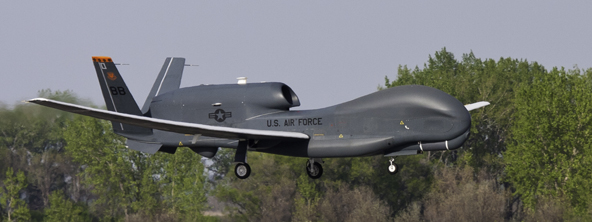U.S. Air Force testers say the Global Hawk Block 20/30 is unable to completely and reliably perform the high-altitude imagery and signals intelligence collection missions for which it is designed.
Major General David Eichorn, who heads the Air Force Operational Test and Evaluation Center in New Mexico, says he found the system to be “effective with significant limitations … not suitable and partially mission capable” in the Initial Operational Test and Evaluation (IOT&E) report he approved May 20.
Eichorn acknowledges this is an unusual finding. Typically, systems are considered effective or not effective. “I was much more comfortable with the shade of grey in this case rather than the black and white of is it effective or not,” he tells Aviation Week in a June 3 interview. “This provides a valuable service to our nation, and to the allies … I felt more comfortable calling it effective because it does do some things well. But it has got a ways to go to being all that we want it to be.”
Of note during the three months of testing last fall at Beale AFB, Calif., (the first Global Hawk home base), was poor sortie turnaround performance. Effective time on station (ETOS), or the amount of time the aircraft can loiter over a target gathering intelligence, was expected to be 55%, but the system achieved only 27%. Part of that was owing to an electrical generator issue. Action by the programme office and contractor Northrop Grumman to fix this problem was “impressive,” Eichorn says.
Another factor contributing to poor ETOS performance was low-tech, but crippling. “Nut plates,” or panels on the aircraft, were breaking when maintainers opened and closed them. Fixes require a 24-hr. curing time, Eichorn says, effectively keeping an aircraft on the ground for a day without operations. He likens this requirement to airline operations; the airlines lose money if a jet is grounded. Spares availability also was a problem, an issue often heard with young systems.
Also problematic during the IOT&E period was performance by the two sensor payloads, the Raytheon Enhanced Integrated Sensor Suite (EISS) and Northrop Grumman Airborne Signals Intelligence Payload (ASIP). In both cases the sensors performed well at close range, but the imagery is “not so good” at longer distances once the slant range of the sensor begins to degrade, Eichorn says. The general notes that SAR performance was good, if the aircraft is close to its target.
Likewise, performance of the sensors has been good during actual operations, Eichorn notes. Two examples are the images of Japan’s failing nuclear power plant collected by Global Hawk after the recent earthquake there. Also, the system provided images of targets in Libya—both areas with permissive operations. Eichorn explains that Global Hawk was not designed to penetrate deep into hostile airspace.
However, slant ranges are important for standoff intelligence collectors. The U-2, for example, is credited with having good slant range performance, allowing it to peer behind borders at targets. Eichorn declined to provide actual ranges for the Global Hawk’s performance owing to security concerns.
The report’s findings appear damning to a programme that has had its share of struggles, twice breaching Nunn-McCurdy cost-growth caps. But while Global Hawk has faced a stiff headwind in Washington on cost and now with its testing findings, the system has support in the field. This juxtaposition is reminiscent of the Predator UAS, made by rival General Atomics, for which testers issued an equally scathing performance report. However, that system—as well as the larger Reaper and Gray Eagle versions—are hailed by field commanders as successful.
Source: Aviation Week

